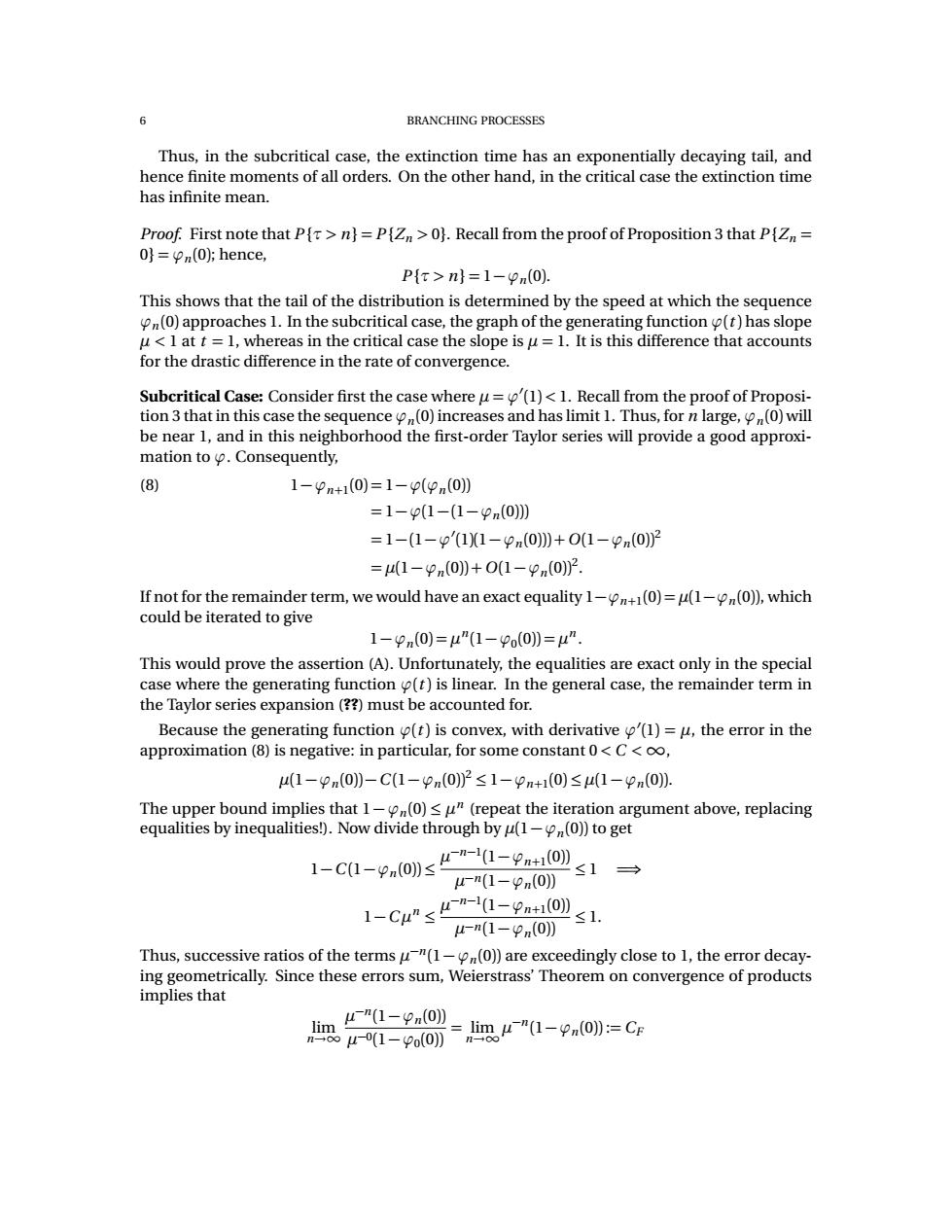正在加载图片...

BRANCHING PROCESSES Thus,in the subcritical case,the extinction time has an exponentially decaying tail,and hence finite moments of all orders.On the other hand,in the critical case the extinction time has infinite mean. Proof.First note that P{>n}=P(Zn >0).Recall from the proof of Proposition 3 that P(Zn= 0)=n(0);hence, P{x>n}=1-pn(0) This shows that the tail of the distribution is determined by the speed at which the sequence n(0)approaches 1.In the subcritical case,the graph of the generating function o(t)has slope u<1 at t =1,whereas in the critical case the slope is u=1.It is this difference that accounts for the drastic difference in the rate of convergence. Subcritical Case:Consider first the case where u=(1)<1.Recall from the proof of Proposi- tion 3 that in this case the sequence(0)increases and has limit 1.Thus,for n large,(0)will be near 1,and in this neighborhood the first-order Taylor series will provide a good approxi- mation to Consequently, (8) 1-9n+1(0)=1-p(pn(0刃 =1-p(1-(1-9n(0) =1-(1-9'(11-pm(0)+O(1-pn(0)2 =41-9n(0)+0(1-9n0)2 If not for the remainder term,we would have an exact equality 1-n+(0)=u(1-n(0)),which could be iterated to give 1-9n(0)=μ"(1-9o(0)=μ”. This would prove the assertion(A).Unfortunately,the equalities are exact only in the special case where the generating function o(t)is linear.In the general case,the remainder term in the Taylor series expansion(??)must be accounted for. Because the generating function (t)is convex,with derivative (1)=u,the error in the approximation(8)is negative:in particular,for some constant 0<C<oo, 41-Pn(0)-C1-9n(02≤1-9n+1(0)≤4(1-9n(0. The upper bound implies that 1-(0)<u"(repeat the iteration argument above,replacing equalities by inequalities!).Now divide through by u(1-(0))to get 1-C1-9n0≤0-0-2*10)】 c1-9n0s1→ 1-C4"≤0-1-9n+10 ≤1 u-n(1-pn(0) Thus,successive ratios of the terms u"(1-(0))are exceedingly close to 1,the error decay- ing geometrically.Since these errors sum,Weierstrass'Theorem on convergence of products implies that lim μ-"(1-pn(0) n-0-0(1-9o(0)n= =,li"(1-9n(o)=Cp6 BRANCHING PROCESSES Thus, in the subcritical case, the extinction time has an exponentially decaying tail, and hence finite moments of all orders. On the other hand, in the critical case the extinction time has infinite mean. Proof. First note that P {τ > n} = P {Zn > 0}. Recall from the proof of Proposition 3 that P {Zn = 0} = ϕn (0); hence, P {τ > n} = 1 − ϕn (0). This shows that the tail of the distribution is determined by the speed at which the sequence ϕn (0) approaches 1. In the subcritical case, the graph of the generating function ϕ(t ) has slope µ < 1 at t = 1, whereas in the critical case the slope is µ = 1. It is this difference that accounts for the drastic difference in the rate of convergence. Subcritical Case: Consider first the case where µ = ϕ 0 (1) < 1. Recall from the proof of Proposition 3 that in this case the sequence ϕn (0) increases and has limit 1. Thus, for n large, ϕn (0) will be near 1, and in this neighborhood the first-order Taylor series will provide a good approximation to ϕ. Consequently, 1 − ϕn+1 (8) (0) = 1 − ϕ(ϕn (0)) = 1 − ϕ(1 − (1 − ϕn (0))) = 1 − (1 − ϕ 0 (1)(1 − ϕn (0))) + O(1 − ϕn (0))2 = µ(1 − ϕn (0)) + O(1 − ϕn (0))2 . If not for the remainder term, we would have an exact equality 1−ϕn+1 (0) = µ(1−ϕn (0)), which could be iterated to give 1 − ϕn (0) = µ n (1 − ϕ0 (0)) = µ n . This would prove the assertion (A). Unfortunately, the equalities are exact only in the special case where the generating function ϕ(t ) is linear. In the general case, the remainder term in the Taylor series expansion (??) must be accounted for. Because the generating function ϕ(t ) is convex, with derivative ϕ 0 (1) = µ, the error in the approximation (8) is negative: in particular, for some constant 0 < C <∞, µ(1 − ϕn (0)) − C (1 − ϕn (0))2 ≤ 1 − ϕn+1 (0) ≤ µ(1 − ϕn (0)). The upper bound implies that 1 − ϕn (0) ≤ µ n (repeat the iteration argument above, replacing equalities by inequalities!). Now divide through by µ(1 − ϕn (0)) to get 1 − C (1 − ϕn (0)) ≤ µ −n−1 (1 − ϕn+1 (0)) µ−n (1 − ϕn (0)) ≤ 1 =⇒ 1 − C µ n ≤ µ −n−1 (1 − ϕn+1 (0)) µ−n (1 − ϕn (0)) ≤ 1. Thus, successive ratios of the terms µ −n (1 − ϕn (0)) are exceedingly close to 1, the error decaying geometrically. Since these errors sum, Weierstrass’ Theorem on convergence of products implies that limn→∞ µ −n (1 − ϕn (0)) µ−0(1 − ϕ0 (0)) = limn→∞ µ −n (1 − ϕn (0)) := CF